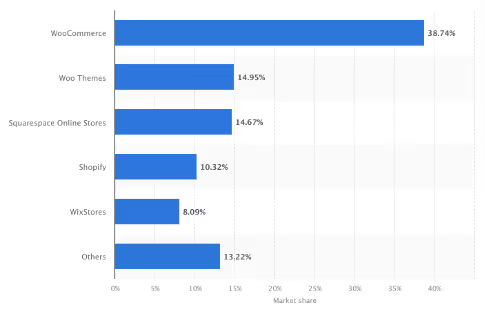Ensuring a seamless transition: How to prepare for your ecommerce site migration


Ecommerce stores constantly evolve and improve their business operations to meet changing market needs, customer preferences, and industry trends. At times, such evolution may require a business to migrate or re-platform its ecommerce site, which can be overwhelming and complex.
As much as 27% of ecommerce businesses are thinking about migration, but to ensure a seamless transition, you need to carefully consider and take numerous steps. In this article, we'll delve into the process of eCommerce migration, why businesses opt for an ecommerce re-platforming project, and how to prepare for a successful ecommerceecommerce site migration.
What is ecommerce migration?
Ecommerce migration is the process of moving your ecommerce site from your current platform to another, to a newer version of the same platform, or to a new host. It can also involve making other types of changes to your entire website (e.g. data, design, and content).
What are the different types of ecommerce migration?
It's essential to identify the type of ecommerce migration required based on the needs of the ecommerce business and to plan the ecommerce migration project accordingly.
Platform migration
This type of migration involves moving from your current platform to another (re-platforming process), such as moving from Magento to Shopify Plus or from WooCommerce to BigCommerce.
Version upgrade migration
This type of migration involves upgrading to a newer version of the same ecommerce platform. For example, this would include upgrading from Magento 1 to Magento 2 or from WooCommerce 5.0 to WooCommerce 6.0.
Hosting migration
Hosting migration involves moving from one hosting provider to another, like moving from a shared hosting plan to a VPS or dedicated server.
Data migration
If you want to move data from one ecommerce platform/URL to another, you need ecommerce data migration. This could include product data, customer data, order history, and other relevant data.
Design and content migration
Finally, this type of migration involves migrating the design and content of the website. This could include migrating custom themes, plugins, and content like blog posts and product descriptions.
Why do ecommerce businesses re-platform?
There are several reasons why online businesses consider ecommerce platform migrations:
- Outdated technology: As technology evolves, ecommerce platforms may become outdated, making it difficult to keep up with the latest trends and customer expectations.
- Poor user experience: An ecommerce site with a poor user experience can significantly impact conversions (e.g. high bounce rates), customer loyalty and retention (e.g. loss of customers), and ultimately revenue. Migrating to a new platform can help address these issues and provide a better user experience.
- Scalability issues: As a business grows, its ecommerce platform needs to be able to scale with it. Migrating to a platform that can handle increased traffic and sales is essential to support business growth.
- Tapping into new markets: ecommerce migration can help businesses expand to new markets. The best ecommerce platforms offer advanced inventory management, payment gateways, and shipping options, as well as multilingual and multicurrency capabilities.
- Better data analytics: A robust ecommerce platform with advanced analytics features provides critical insights into vital metrics like average order value, conversion rate, and revenue per customer, helping you enhance lead conversions, reduce abandonment rates, establish optimal product pricing, and accurately allocate budgets.
- Integration with third-party applications: Integrating third-party apps, such as payment gateways, shipping providers, and marketing tools, can be challenging on certain platforms. ecommerce platform migrations can make integration more seamless and efficient.
- Cost: Some ecommerce platforms may become expensive over time as businesses grow, making it difficult to manage operational costs effectively. Re-platforming to a more cost-effective platform can help an online business manage its budget more efficiently.
Take a look at our case study to see how one of our clients successfully migrated their ecommerce website using Noibu.
5 ecommerce platforms to consider
There are several ecommerce platforms available in the market, each with its unique features, functionalities, and pricing. Some of the most popular ecommerce solutions to consider include:
Shopify Plus
Shopify Plus is an enterprise-level version of the popular Shopify ecommerce platform. It is designed to meet the needs of high-growth, high-volume businesses and offers a range of advanced custom features and capabilities not available on the standard Shopify plan.
Magento
Magento is an open-source platform that powers Adobe Commerce. It provides flexibility and customization options for businesses with complex ecommerce needs. It's a great platform for large businesses or those with high-volume sales.
SAP Hybris
SAP Hybris is a popular enterprise-level ecommerce platform designed for large-scale businesses. It offers a wide range of features, including product content management, order management, and omnichannel commerce capabilities.
Salesforce Commerce Cloud
Salesforce Commerce Cloud is a cloud-based ecommerce platform that enables businesses to create and manage personalized, omnichannel shopping experiences for their customers. It offers a range of features, including product catalogs, promotions, order management, and artificial intelligence capabilities.
WooCommerce

WooCommerce is a plugin for WordPress that provides ecommerce capabilities. It's ideal for small businesses or those with basic ecommerce needs, and it’s the most widely used platform with almost 39% market share.
BigCommerce
BigCommerce is a cloud-based platform that provides a wide range of features, including design templates, payment gateways, and marketing tools. It's suitable for businesses of all sizes and industries.
Custom solutions
Finally, if you’re an ecommerce brand that is looking for a fully customized ecommerce platform to tailor it to your business, a custom solution may be the best choice. In fact, many of our clients choose this option, and you can read more about the pros and cons of a custom ecommerce platform vs off-the-shelf.
How to choose the right ecommerce platform
Choosing the right ecommerce platform is critical to the success of your ecommerce store migration, so here are some key factors to consider:
- Consider your business requirements, such as the type of products you sell, the volume of sales, as well as the level of customization required.
- Think about the cost of the platform, including any ongoing fees, such as transaction fees or hosting costs.
- Ensure the platform can handle your business's growth over time.
- Consider the platform's user experience and how it aligns with your brand and customer needs.
- Make sure the platform can integrate with any third-party applications you currently use or may need in the future.
- Consider the level of support the platform offers, including documentation, customer service, and community resources.
Creating your ecommerce migration plan
If you want to ensure a seamless transition, creating a comprehensive ecommerce migration strategy is critical. This migration plan will make the process and your life easier.
First things first
The initial step involves defining the scope of your migration and determining the changes that you intend to make to your site. This could include retaining the existing site structure or making modifications to navigation, product categories, and other elements.
Consider the following factors:
- Domain: Verify that you have access to your domain so that you can update the domain name server (DNS) record to the new server if you switch website hosts.
- SSL certificate: Check whether your SSL certificate is compatible with the new server and if it can be transferred.
- URLs: Determine whether your URLs will change following the site migration. If they do, you'll need to set up 301 redirects to avoid losing search engine rankings and ensure that users can access your new pages via links.
Assess your current ecommerce site
Next, assess your current ecommerce site thoroughly to identify any potential challenges and develop a plan to address them.
Here are some key areas to assess:
- Site design and user experience: Review your site's design, layout, and user experience. Consider how easy it is to navigate, whether the site is responsive, and whether the design is consistent with your brand.
- Site functionality: Evaluate the functionality of your site, including features such as the shopping cart, checkout process, and payment gateway. Identify any issues or limitations that may impact your ability to sell products online.
- Data and content: Take stock of all the data and content you have on your current site, such as product information, customer info, and order history. Identify any issues with data quality or completeness that may need to be addressed before migration.
- Integrations: Review any third-party applications or services that integrate with your current ecommerce platform. Identify any potential issues with compatibility or data transfer that may need to be addressed during the migration process.
Set goals for the migration
Once you've assessed your current ecommerce site, it's time to set clear goals for the migration. These goals should align with your business's broader strategic objectives and include specific outcomes you want to achieve, such as improved user experience, increased sales, or better integration with third-party applications.
Here are some key steps to consider when setting goals for the migration:
- Identify the outcomes you want to achieve: Consider the broader business objectives and identify the specific outcomes you want to achieve through the migration process. These may include improving site performance, increasing sales, or enhancing the user experience.
- Set specific, measurable goals: Ensure that each goal is specific, measurable, achievable, relevant, and time-bound (SMART). This will help you track progress and measure the success of the migration process.
- Prioritize your goals: Once you've identified the outcomes you want to achieve, prioritize them based on their importance to your business objectives.
Identify risks and mitigation strategies
As with any major project, ecommerce migration comes with risks. These risks can include data loss, website downtime, and compatibility issues with third-party applications. Identifying these risks and developing mitigation strategies can help minimize the impact of these risks.
- Identify potential risks: Consider all the potential risks associated with ecommerce migration, including technical issues, data loss, and compatibility issues with third-party applications.
SEO and downtime are also two important aspects which can suffer great risk during the migration process. SEO can be significantly affected due to a drop in traffic and rankings, and if the new platform isn’t set up correctly, it can lead to a temporary loss of sales and traffic to the website.
- Assess the impact of each risk: Determine the potential impact of each risk on your business and prioritize them based on their severity.
- Develop mitigation strategies: Develop strategies to mitigate each risk, such as regular data backups, thorough testing, and contingency plans for website downtime.
Identify Key Performance Indicators (KPIs)
To measure the success of the migration process, you should identify KPIs to track. Identifying KPIs and tracking them throughout the migration process will also help you make data-driven decisions to optimize your new ecommerce platform.
The KPIs should align with the goals you've set for the migration, and they should be measurable and specific. Here are some of them:
- Website traffic: Track the number of visitors to your website before and after the migration to assess the impact on traffic.
- Conversion rate: Measure the conversion rate before and after the migration to determine whether the new platform has improved sales and created an increase in conversion rates.
- Average order value: Track the average order value (before and after) to determine whether the new platform has increased revenue.
- Site performance: Monitor site performance metrics such as page load speed and server response time to ensure that the new platform is performing as expected.
Develop a timeline and budget
In order for the migration process to stay on track and within budget, you should develop a custom migration plan that aligns with your business objectives and minimizes risks:
- Develop a project timeline: Create a timeline for the migration process that includes key milestones and deadlines.
- Allocate resources: Determine the resources required, including personnel, technology, and budget.
- Create a budget: Develop a budget that includes all the operating costs associated with the migration, such as licensing fees, data migration services, and third-party integrations.
Ecommerce migration checklist
Hopefully, all the tips and tactics we mentioned above will be useful in your migration process.

For the sake of having even more clarity and staying organized, make sure to follow this ecommerce migration checklist:
- Determine why you want to migrate your ecommerce site and what your goals are for the new platform.
- Obtain agreement from all stakeholders.
- Research and compare ecommerce platforms to determine which one is the best fit for your business.
- Choose an ecommerce platform that aligns with your business goals, budget, and technical requirements.
- Conduct a thorough assessment of your current ecommerce site to identify any areas for improvement.
- Develop a detailed migration plan that outlines each step of the migration process, including a timeline and budget.
- Ensure that your data is properly formatted and ready for migration to the new platform.
- Make sure to create a backup of your current ecommerce site's data before initiating the migration process to ensure you have a copy of your data in case something goes wrong.
- Notify your customers and stakeholders about the upcoming migration process and any potential disruptions to services during the transition period.
- Design your new website.
- Conduct a comprehensive SEO audit, avoiding content updates and 404 errors.
- Ensure that all SEO settings, such as URLs and meta tags, are properly migrated to the new platform to avoid any negative impact on your SEO rankings (i.e. a drop in rankings).
- Test the migration process to ensure that your data is properly migrated and that your new ecommerce site is functioning as expected.
- Train your team on the new ecommerce platform and any new features or functionality.
- Set up any necessary third-party integrations, such as payment gateways and shipping providers.
- Launch your new ecommerce site and monitor its performance to ensure that everything is working as expected.
- Conduct thorough post-migration testing to ensure that your new ecommerce site is functioning as expected and that all third-party integrations are working properly.
- Continuously monitor and optimize your new ecommerce site to improve performance and user experience, as well as achieve your business objectives.
- Customize your new ecommerce site to align with your brand and create a seamless customer experience.
- Update your payment gateway settings to ensure that payments are properly processed on the new platform.
- Make sure to migrate all product information, including images, descriptions, and pricing, to the new platform.
- Migrate customer information, including order history and account details, to the new platform.
- Update your shipping settings on the new platform to ensure that your customers are properly charged for shipping.
- Monitor traffic and sales on your new ecommerce site to make sure that everything is functioning properly and that your sales are not being impacted negatively.
- Create a customer support plan to ensure that your team is prepared to handle any issues or questions that arise during the transition period.
It’s migration time!
Ecommerce migration can be a complex process, especially if it involves re-platforming. Assessing your current ecommerce site, setting clear goals for the migration, choosing the right eCommerce platform, customizing your new site, as well as testing and QA are all critical components of the ecommerce migration process.
Fortunately, by following a strategic approach and carefully planning each step, you can ensure a seamless and successful migration that meets your business’s and customers’ needs as well as aligns with your broader strategic objectives.
Leverage Noibu to eliminate revenue-impacting bugs on ecommerce websites
However, it's important to note that no matter which ecommerce platform you choose, you can never completely avoid website errors. Bugs and technical glitches show up even at the most unexpected instances, potentially causing your business millions of dollars in lost revenue through the course of the year.
Noibu is an ecommerce error monitoring platform that not only detects and flags website errors in real time, but also calculates the impact that they are predicted to have on annual revenue. The platform provides all the technical details developers need to quickly resolve high-priority errors without having to replicate them or spend hours investigating. Sign up for a demo of the Noibu platform to witness how you can eliminate revenue-impacting bugs on your site (no matter which platform its built on) and boost your annual top line as you successfully plan migration.




